| 1 | Balkan whipsnake |
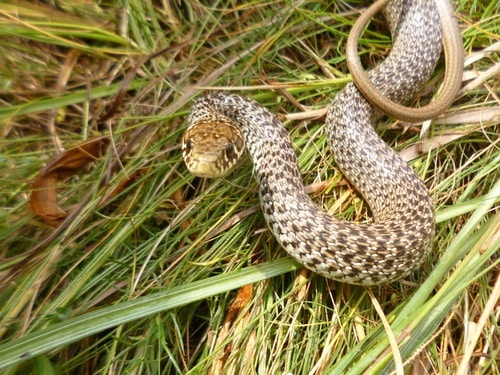
One of Greece’s most common and fastest snakes. Balkan whipsnakes (Hierophis gemonensis) live all over Greece, from north to south, from west to east. They measure 120-150cm, and primarily inhabit Mediterranean shrubland, rural gardens and cultivated land like olive plantations, where they sometimes rest on olive tree branches themselves.
The Balkan whipsnake has black spots on its upper body, with plainer olive tones on its lower body. It has round pupils, and smooth scales to touch. Males are larger than females, partially because this is a wrestling snake that engages in ritual combat for female affections, a sight which probably terrified invading Turkish armies back in the day. There has never been a fully fledged study on this species’ diet, but there’s plenty of anecdotal sightings, such as a Balkan whipsnake swallowing a dice snake whole in Croatia. Smooth snakes and Aesculapian snakes are also confirmed meals. They seem to shun mammals in favour of lizards and other reptiles.
The Balkan whipsnake is most closely related to the green whipsnake (Hierophis viridiflavus), one of Italy’s most common snakes. They look and act similarly, but a 2015 genetic study found an estimated divergence time of 7 million years ago. Balkan whipsnakes only reach the extreme northeast of Italy.
| 2 | Nose-horned viper |
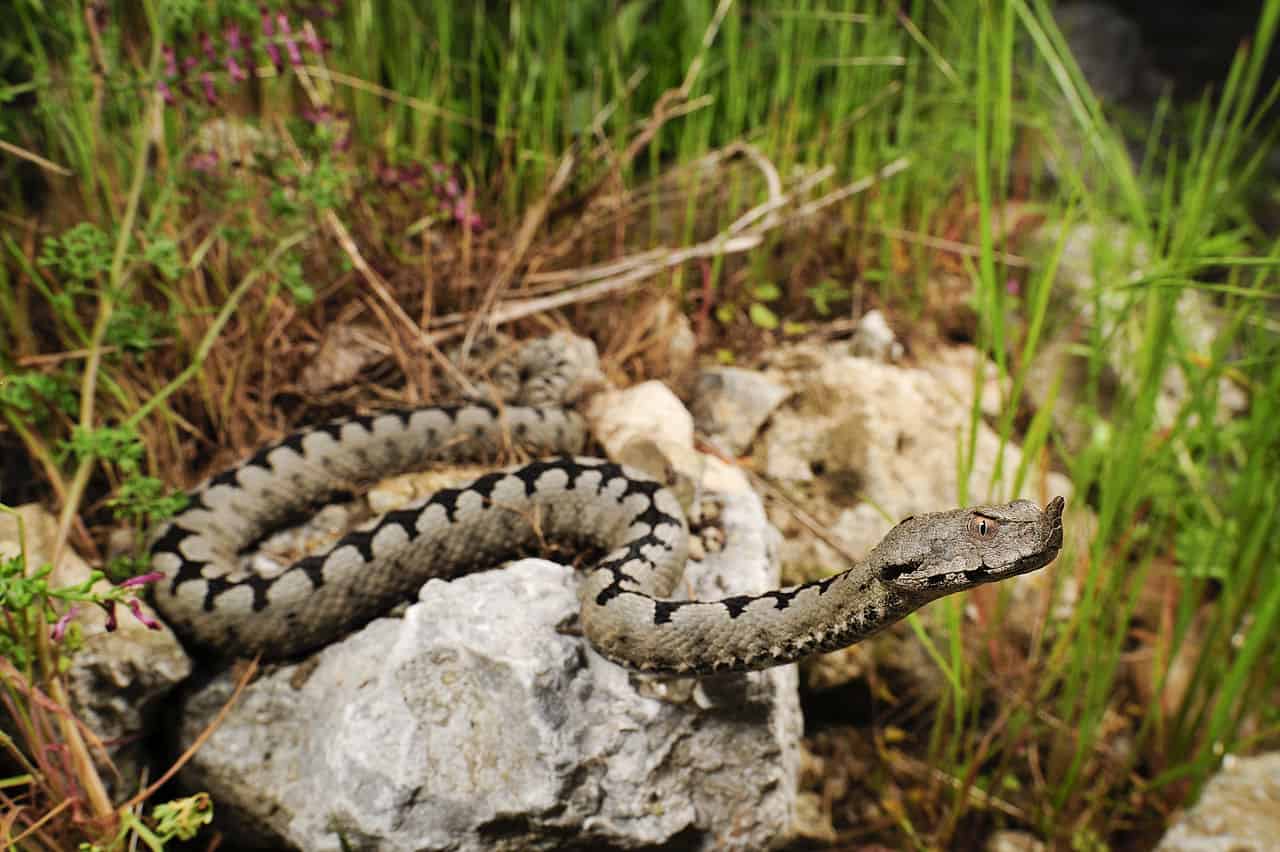
Easily Greece’s most common venomous snake. You won’t find the nose-horned viper (Vipera ammodytes) in your back garden or punching up through an Athens sewer, but they’re abundant in rocky fields, craggy rocky slopes favoured by climbers, and even beaches, such as on the Cyclades islands of Los and Mykonos. They’re instantly recognisable by their horned snout, with a varying angle from horizontal to vertical, usually between.
A 2006 study analysed snakebites in Greece specifically, testing 147 nose-horned viper bites from 1995 to 2005. None were fatal, and swelling was a near universal symptom, at 98.64% of patients. A pounding heartbeat affected 32.65%, fainting or dizziness 29.93%, fever 23.13%, nausea 16.33% and vomiting 12.93%.
They’re normally grey, with males being particularly stony, and females sometimes being brown. A rounded zigzag down their spine is a classic ID sign. Nose-horned vipers are also found in the wilderness surrounding Mount Olympus, and are considered common, not rare. In the Cyclades, they’re found on 15 islands overall, and these island dwellers are smaller than their mainland Greek counterparts. Luckily, nose-horned vipers only attack if harassed and provoked. This species eats 61-86% mammals, the remainder consisting of lizards, occasional birds, and even venomous centipedes. In Greece, they’ve been observed eating Megarian banded centipedes and snake-eyed lizards.
| 3 | Leopard snake |
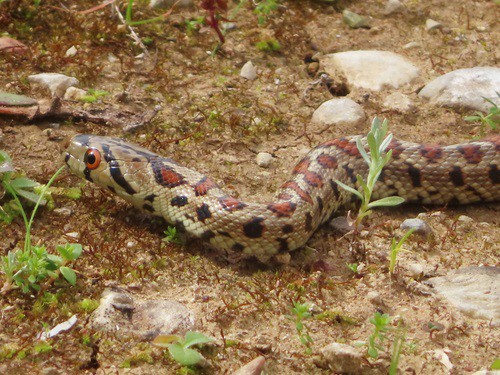
A non-venomous constrictor which avoids dense forests, and prefers olive groves, fields, and intermingled plains of bushes and rocks. Leopard snakes reach a maximum of 90cm, and cover the whole of mainland Greece, including the outskirts of Athens. Leopard snakes love old stone ruins, and in rural Greece, there’s plenty to choose from.
This species has memorable copper blotches contrasting against a grey or olive undertone. Their head has a V-shaped marking which leads to confusion with vipers, but their pupils are round rather than viciously vertical. Leopard snakes also have vivid black stripes connected to their eyes.
Most of their confirmed prey are mammals – bank voles, Etruscan shrews, Savi’s pine voles, plus an Italian wall lizard. In Peloponnese, Greece, a captured leopard snake regurgitated a slug, which is a rare meal for a snake, and especially rare in Europe. This snake lacks venom, but may have more subtle skills.
Greece has been a cradle of civilisation for thousands of years, yet somehow leopard snakes are still being discovered in new locations – in 2015 they were discovered on the island of Chalki for the first time. The tourist islands of Rhodes and Crete are also hotspots. This species is incapable of harming humans.
| 4 | Grass snake |
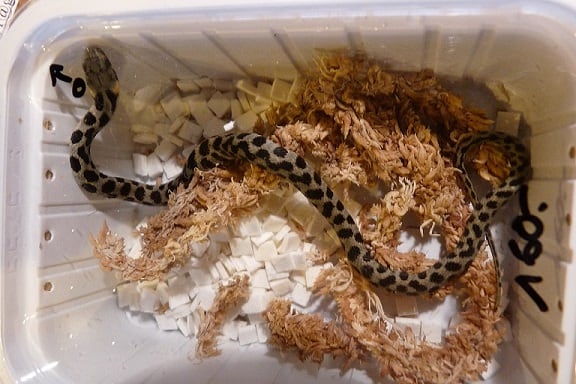
Virtually no corner of Europe except the far north is free from the humble grass snake. This harmless species lives in ponds and survives by playing dead, releasing a foul snake smell, and thrashing around until you put them down out of sheer annoyance.
Grass snakes inhabit most of Greece, where they have a few interesting quirks. There’s two subspecies in the country: Natrix natrix persa and Natrix natrix schweizeri. The latter is concentrated on the islands of Milos, Kimolos and Polyaegos and has a unique pattern of dense black squares against an olive undertone. This has made them popular in captivity, and they’re also less aquatic than traditional grass snakes. N. natrix schweizeri is one of the most distinctive subspecies, alongside the bluish grass snakes (N. natrix cetti) of Sardinia in Italy.
Meanwhile, Natrix natrix persa lives on the Greek mainland, and has thinner and more numerous, but dense black spots covering its flanks. This subspecies starts in Greece and extends to Turkmenistan.
In 2018, grass snakes were discovered on a new Greek island: Karpathos. On the mainland, expect to find grass snakes in ponds, small streams and damp meadows.
| 5 | European catsnake |
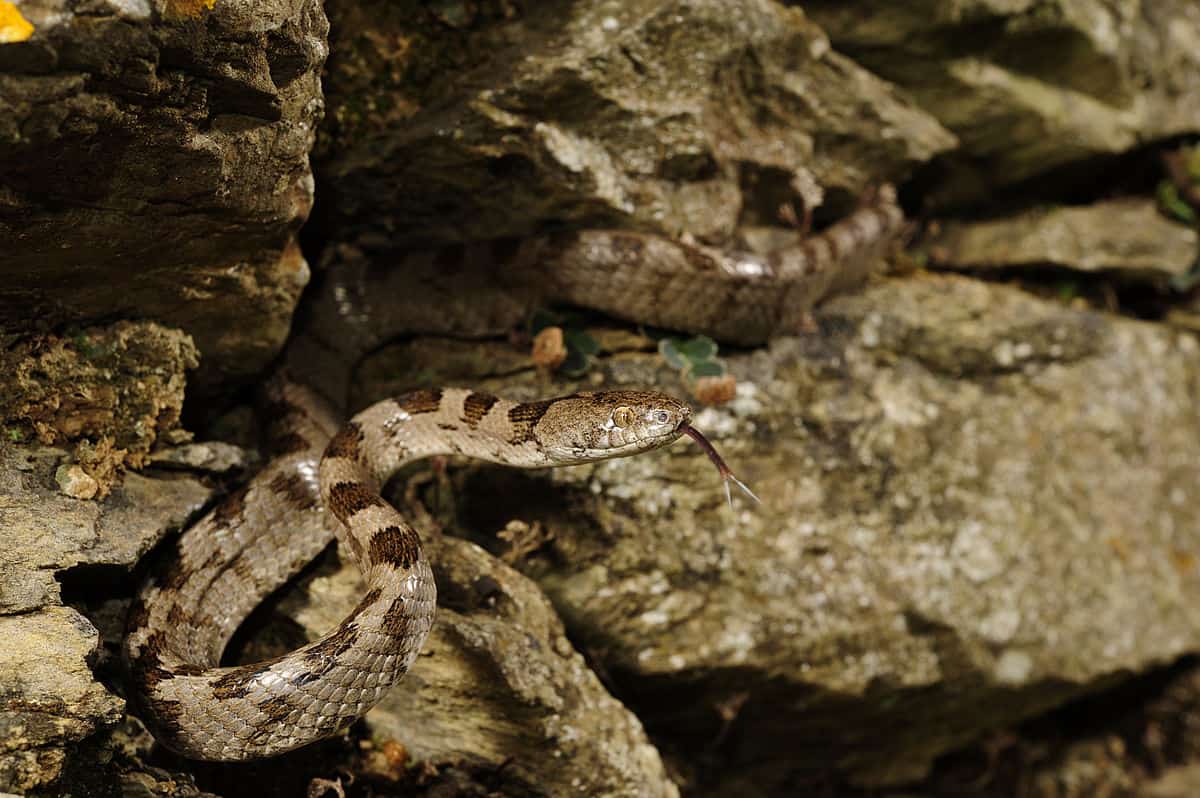
A mildly venomous snake, which secretes toxins through its rear fangs and struggles to inject them into humans. This is the only venomous snake in Crete, but not one you need to be slightly concerned about.
European catsnakes (Telescopus fallax) inhabit virtually all of Greece, including the outskirts of Athens. They inhabit Albania and Macedonia to the northwest, and Turkey to the east, so Greece lies pretty much at the centre of their range. Cat-eyed snakes hunt at night and produce a strange whistle when cornered. They figure in religious ceremonies, as supposedly when the nuns were under attack by Turkish soldiers, they prayed to God, who delivered a sudden influx of catsnakes which terrified the Turks into fleeing. Annual ceremonies on the island of Cephalonia still honour this snake.
European cat snakes occupy the reptile-eating niche, and prefer rocky hillside slopes and open oak forests. With their olive and grey blotches, Telescopus fallax can look extremely similar to vipers from a distance. Both have vertical pupils as well. But with nose-horned vipers, the dark blotches run down their spine in a continuous unbroken stream, like a zigzag with circular edges. In European catsnakes they’re broken up, sometimes arranged in alternating light and dark squares.
| 6 | Milos viper |
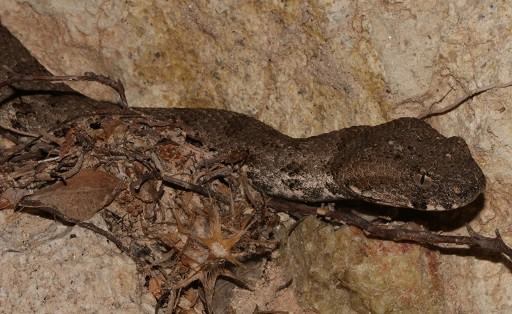
An endangered viper confined solely to Greek’s Cyclades islands off the south coast. The Milos viper belongs to the Macrovipera family, which has up to 5 members. This was originally a subspecies of the Levant viper (M. lebitinus), found in Turkey, but the Cyclades islands have been isolated from the mainland for 12 million years, and hence this Greek version was made independent. The Milos viper maxes out at 98.5cm, and has bizarre rumours of jumping 5 metres at once.
Milos vipers prefer rural areas, particularly small valleys with streams which dry out during summer. They like scattered tree clumps, as they’re relatively arboreal (tree-climbing) for a viper, lurking on the branches to snatch birds out of mid-air. Milos vipers also lurk on old stone walls adjacent to fields. Of course, if you stick to the Greek mainland, you’ll never have a chance of meeting one. Milos vipers are also found on Kimolos, Polyegos and Sifnos nearby, but not the island of Antimilos.
Unlike the Turkish levant viper, which hunts small mammals, the Milos viper mainly hunts birds, while analysis of its venom revealed tailored a toxin profile against lizards. The venom causes mainly local symptoms like swelling and haemorrhaging. It contains procoagulants which stimulate factor X, the clotting conversion mediator, depleting important fibrinogen supplies, although less strongly than its mainland Macrovipera cousins.
| 7 | Dahl’s whipsnake |
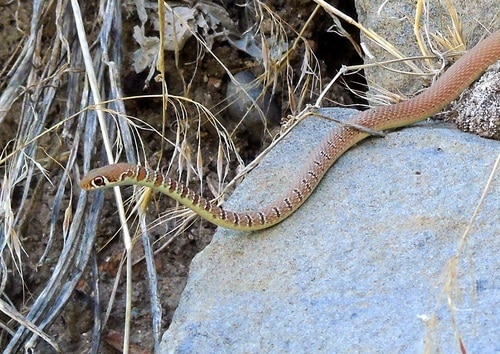
Another species that covers virtually all of Greece, as well as Albania to the west and Turkey to the east. Dahl’s whipsnakes are fast and thin, regularly reaching 120cm. Instead of an ambush predator, this is an actively foraging snake with an abundance of energy. Dry, open habitats with plenty of stones are their favourite, like hilly steppe or near sheep fields.
Their adventurous ways often bring them to roads, where they meet their demise under a car tyre. With nose-horned vipers focussing on mammals, Dahl’s whipsnakes have seized the lizard niche, and are eaten themselves by eastern montpellier snakes.
The signature of this species is patterns which completely vanish in the lower two thirds of the body. The upper third has black blotches or stripes, contrasting against a grey or olive undertone. The lower body is plain, with neither stripes nor bands, and the colour flips to orange. Meanwhile, their eyes have round pupils and a reddish iris. The longest Dahl’s whipsnake once measured 152cm, discovered in Bulgaria. On September 25th 2012, this was roundly defeated, with a new record of 172cm, discovered in the Kvemo Kartli region of Georgia, near an industrialised nitrogen fertilizer plant.
| 8 | Eurasian worm snake |
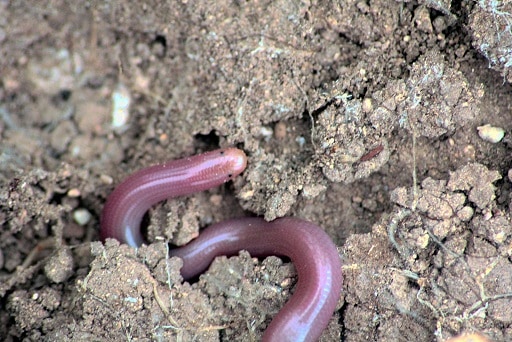
A Greek species which is everywhere in the country, but successfully lurks out of sight. This is Greece’s most common blind snake species – the Eurasian worm snake (Xerotyphlops vermicularis), a tiny snake measuring just 16-25cm, with a maximum of 36cm. Its tail is particularly small, comprising just 2-4% of its body. This is a fossorial snake with shrivelled eyes, that perceive only changes in overall light intensity. Greece is the western area of their range – their other territories include Turkey, Georgia, and Azerbaijan.
Eurasian worm snakes are most common at lower elevations on hillsides, sparsely grassy fields and areas covered with rocks and shrubs. They can’t cope with sand, as they require soil to dig into, but they appear in semi-arid areas, plus the edges of agricultural fields. Xerotyphlops vermicularis lurks under stones and underground tunnels such as insect burrow networks.
Eurasian worm snakes prey on a chunk of ants, and have a transparent belly, which allows scientists to spy their meals without even dissecting them. This species lays barely any eggs, just 1-3 per batch, which have an elongated shape. Hiding is their main strategy for survival.
| 9 | Greek viper |
This rare viper has less than a tenth of the nose-horned viper’s overall territory. Greek vipers inhabit a small stretch of western Greece, just crossing the border with Albania. The status of this viper is murky, as it’s either an independent species called Vipera graciae, or a subspecies of the meadow viper which is scattered across Europe.
Either way, this is a 30-45cm species of open grassy meadows, usually with plenty of rock and shrub cover. It lives in high altitude areas typically covered with melting snow during winter, specifically the Pindus mountain range, which reaches a maximum elevation of 2,637 metres at Mount Smolikas.
A 2016 study discovered 78 live Greek vipers, and all were on alpine meadows above 1600 metres in elevation. They found them on several new mountains, including Griba, Shendelli, Llofiz, Tomorr, Dhëmbel and Trebeshinë mountains. They particularly lurked near shrubs or jumbled rock piles on south-facing slopes. Consequently, it’s mainly weekend hikers who bump into this venomous serpent. 97% of their prey comes from the Orthoptera insect family (grasshoppers, crickets, locusts), including species like wing-buzzing grasshoppers and wart-biters.
Meanwhile, the final of the 3 Vipera members in Greece is the adder (Vipera berus), which is pretty much a non-factor, as it only inhabits the far north of Greece, just spilling over the borders of Albania and Bulgaria.
| 10 | Eastern montpellier snake |
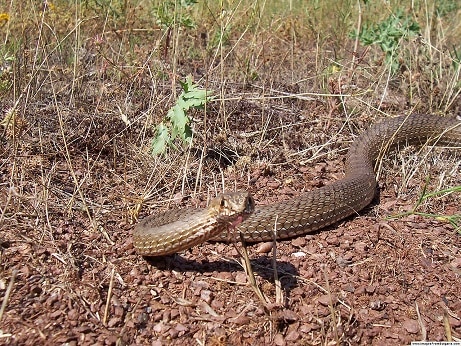
A sizeable snake which is usually longer than 1 metre, and has flexible habitats, appearing in open rural meadows and Mediterranean shrubland, but also towns. Eastern montpellier snakes are mildly venomous, though incapable of killing, and generally have indistinct patterns. They have a taste for other snakes, with dice snakes and Dahl’s whipsnakes both confirmed in their diets. A confirmed lizard prey is the ocellated bronze skink.
Montpellier snakes are very agile, moving by day, and with strong powers to swim and climb alike, dashing up stone walls without thinking. Their territory begins in the extreme northeast of Italy, covers the whole Balkan area before reaching Greece, and continuing through Turkey and the middle east.
Specifically, this Greek version is the eastern montpellier snake. The western montpellier snake (Malpolon monspessulanus) ranges from northwest Italy, through Spain and Portugal, to northwest Africa. Originally, the two species were considered as one, but genetic testing revealed a divergence date of 3.5-6 million years ago. Eastern montpellier snakes are slightly paler, and their record lengths are lower. The western version peaked at 2.4 metres, while the record for Malpolon insignitus is 200cm from Jordan, followed by 183cm in Egypt. The records in Bulgaria are 167cm and 156.8cm.